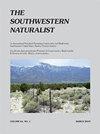IMPACT OF CLIMATE CHANGE ON BIOMES OF TAMAULIPAS AND BIOSPHERE RESERVES, EL CIELO AND SIERRA DE TAMAULIPAS, IN MEXICO
IF 0.2
4区 环境科学与生态学
Q4 Agricultural and Biological Sciences
引用次数: 0
Abstract
Abstract We analyzed the distribution of climatic habitat suitable for biomes of the state of Tamaulipas, Mexico, under the contemporary climate (1961–1990) and projected to the decade centered on the year 2030. This was achieved through previous modeling of the climatic habitat using random forest of the program R and six different climatic model scenarios. By the year 2030, there will be a reduction in the area occupied by a climatic habitat suitable for temperate biomes: conifer forests (–100% change relative to the area currently occupied), San Lucas pine-oak woodland (–100%), and Madrean-Transvolcanic pine-oak woodland (–34%). In contrast, climatic habitats suitable for dry biomes will expand and some will appear that do not currently exist in Tamaulipas, such as the Sinaloa–Guerrero thornscrub (+38% of the state area occupied). In the area occupied by the Biosphere Reserve “El Cielo,” suitable climatic habitat will diminish for the Gulf Coast thornscrub (–100%), tropical semievergreen forest (–100%), and cloud forest (–99%); however, suitable climatic habitat will increase inside that Reserve for the biomes chaparral (+1,703%) and Madrean-Transvolcanic pine-oak woodland (+33%). In addition, habitat suitable for the dry deciduous forest of Sinaloa will appear (+22% of the area of the Reserve, previously nonexistent). For the Biosphere Reserve “Sierra de Tamaulipas,” suitable climatic habitat will be lost mainly for the biomes chaparral (–92%) and Madrean-Transvolcanic pine-oak woodland (–89%). However, habitat suitable to the dry deciduous forest of Sinaloa will appear (66% of the area of the Reserve, which does not currently exist). Modification of the climatic habitat could imply serious challenges for the conservation and management of contemporary vegetation and may provide evidence that the in situ measures of conservation in place for these biome types in the state are insufficient, even within the Biosphere Reserves. Resumen La distribución del hábitat climático propicio para los biomas del estado de Tamaulipas, México, se analizó bajo el clima contemporáneo (1961–1990) y se proyectó a la década centrada en el año 2030. Esto se logró mediante el modelado previo del hábitat climático utilizando el módulo RandomForest del programa R y seis diferentes modelos-escenarios climáticos. Para el 2030, habrá una reducción en el área ocupada por un hábitat climático propicio para biomas templados: bosques de coníferas (pérdida: –100% de cambio en relación con el área actualmente ocupada), bosques de pino-encino de San Lucas (–100%) y bosque de pino-encino de la Sierra Madre y Transvolcánico (–34%). En contraste, los hábitats climáticos propicios para biomas secos se expandirán y aparecerán algunos que actualmente no existen en Tamaulipas, como el matorral espinoso de Sinaloa-Guerrero (ganancia: +38% del área estatal ocupada). En el área ocupada por la Reserva de la Biosfera “El Cielo”, el hábitat climático adecuado disminuirá para el matorral espinoso de la costa del Golfo (–100%), el bosque tropical semi-perennifolio (–100%) y el bosque mesófilo de montaña (–99%); sin embargo, el hábitat climático propicio aumentará dentro de esa Reserva para los biomas de chaparral (+1,703%) y el bosque de pino-encino de la Sierra Madre y Transvolcánico (+33%). Además, aparecerá hábitat propicio para el bosque caducifolio seco de Sinaloa (+22% del área de la Reserva, anteriormente inexistente). Para la Reserva de la Biosfera “Sierra de Tamaulipas”, el hábitat climático propicio se perderá principalmente para los biomas del chaparral (–92%) y el bosque de pino-encino de la Sierra Madre y Transvolcánico (–89%). Sin embargo, aparecerá hábitat propicio para el bosque seco caducifolio de Sinaloa (66% del área de la Reserva, que actualmente no existe). La modificación del hábitat climático podría implicar serios desafíos para la conservación y el manejo de la vegetación contemporánea y puede proporcionar evidencia de que las medidas de conservación in situ para estos tipos de biomas en el estado son insuficientes, incluso dentro de las Reservas de la Biosfera.墨西哥el cielo和sierra de tamaulipas地区气候变化对tamaulipas生物群落和生物圈保护区的影响
摘要我们分析了适应墨西哥塔毛利帕斯州生物群落的气候栖息地在当代气候(1961-1990年)下的分布,并预测到2030年的十年。这是通过以前使用R计划的随机森林和六个不同的气候模型场景对气候栖息地进行建模来实现的。到2030年,适合温带生物群落的气候栖息地所占面积将减少:针叶树森林(-100%与目前占领的地区相比发生变化)、圣卢卡斯松树-橡树林地(-100%)和马德里-火山过渡松树-橡树林地(-34%)。相比之下,适合干生物群落的气候栖息地将扩大,塔毛利帕斯目前似乎不存在一些气候栖息地,如锡那罗亚-格雷罗-桑斯克鲁布(+38%的州面积)。在生物圈保护区“天空”占据的地区,适合海湾海岸荆棘(-100%)、热带半常绿森林(-100%)和云林(-99%)的气候栖息地将减少;然而,该保护区内的Chaparral生物群(+1703%)和Madrian-Transvolcanic Pine-Oak Woodland生物群(+33%)将增加适当的气候栖息地。此外,还将出现适合锡那罗亚干燥落叶林的栖息地(+22%的保护区面积,以前不存在)。对于“Sierra de Tamaulipas”生物圈保护区来说,合适的气候栖息地将主要丧失在Chaparral(-92%)和Madrian-Transvolcanic Pine-Oak Woodland(-89%)生物群落中。然而,将出现适合锡那罗亚干燥落叶森林的栖息地(保护区面积的66%,目前不存在)。气候栖息地的变化可能对当代植被的保护和管理构成严重挑战,并可能提供证据表明,即使在生物圈保护区内,该州对这些生物群落类型采取的现场保护措施也不足。摘要在当代气候(1961-1990年)下分析了墨西哥塔毛利帕斯州有利于生物群落的气候栖息地的分布,并预测了以2030年为中心的十年。这是通过使用R计划的随机森林模块和六种不同的模型-气候情景对气候栖息地进行预先建模来实现的。到2030年,由有利于温带生物群落的气候栖息地占据的地区将减少:针叶树森林(与目前占领的地区相比,损失:-100%)、圣卢卡斯松林(-100%)和马德雷山脉和过渡火山松林(-34%)。相比之下,有利于干生物群落的气候栖息地将扩大,塔毛利帕斯目前不存在的一些气候栖息地将出现,例如锡那罗亚-格雷罗的荆棘灌木丛(收益:+38%的被占领州面积)。在“天空”生物圈保护区占领的地区,墨西哥湾沿岸多刺灌木丛(-100%)、半多年生热带森林(-100%)和山地中生林(-99%)的适当气候栖息地将减少;然而,在这一保护区内,查帕拉尔生物群落(+1703%)和马德雷山脉和跨火山松柏林(+33%)的有利气候栖息地将增加。此外,锡那罗亚干燥的落叶森林(+22%的保护区,以前不存在)将出现有利的栖息地。对于“Sierra de Tamaulipas”生物圈保护区,有利的气候栖息地将主要丧失在Chaparral生物群落(-92%)和Madre和Transvolcanic Sierra松树-橡树林(-89%)。然而,锡那罗亚的干燥落叶森林(保护区面积的66%,目前不存在)将出现有利的栖息地。气候栖息地的变化可能对当代植被的保护和管理构成严重挑战,并可能提供证据表明,即使在生物圈保护区内,该州对这些类型的生物群落的现场保护措施也不足。
本文章由计算机程序翻译,如有差异,请以英文原文为准。
求助全文
约1分钟内获得全文
求助全文
来源期刊

Southwestern Naturalist
环境科学-生态学
CiteScore
0.50
自引率
50.00%
发文量
47
审稿时长
18-36 weeks
期刊介绍:
The Southwestern Naturalist (a publication of the Southwestern Association of Naturalists since 1953) is an international journal (published quarterly) that reports original and significant research in any field of natural history. This journal promotes the study of plants and animals (living and fossil) in the multinational region that includes the southwestern United States, Mexico, and Central America. Appropriate submission of manuscripts may come from studies conducted in the countries of focus or in regions outside this area that report significant findings relating to biota occurring in the southwestern United States, Mexico, and Central America. Publication is in English, and manuscripts may be feature articles or notes. Feature articles communicate results of completed scientific investigations, while notes are reserved for short communications (e.g., behavioral observations, range extensions, and other important findings that do not in themselves constitute a comprehensive study). All manuscripts (feature articles and notes) require an abstract in both English and Spanish.
 求助内容:
求助内容: 应助结果提醒方式:
应助结果提醒方式:


